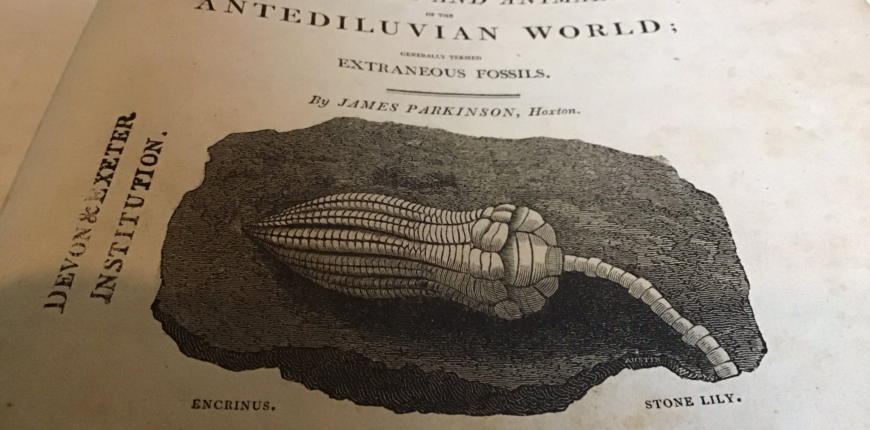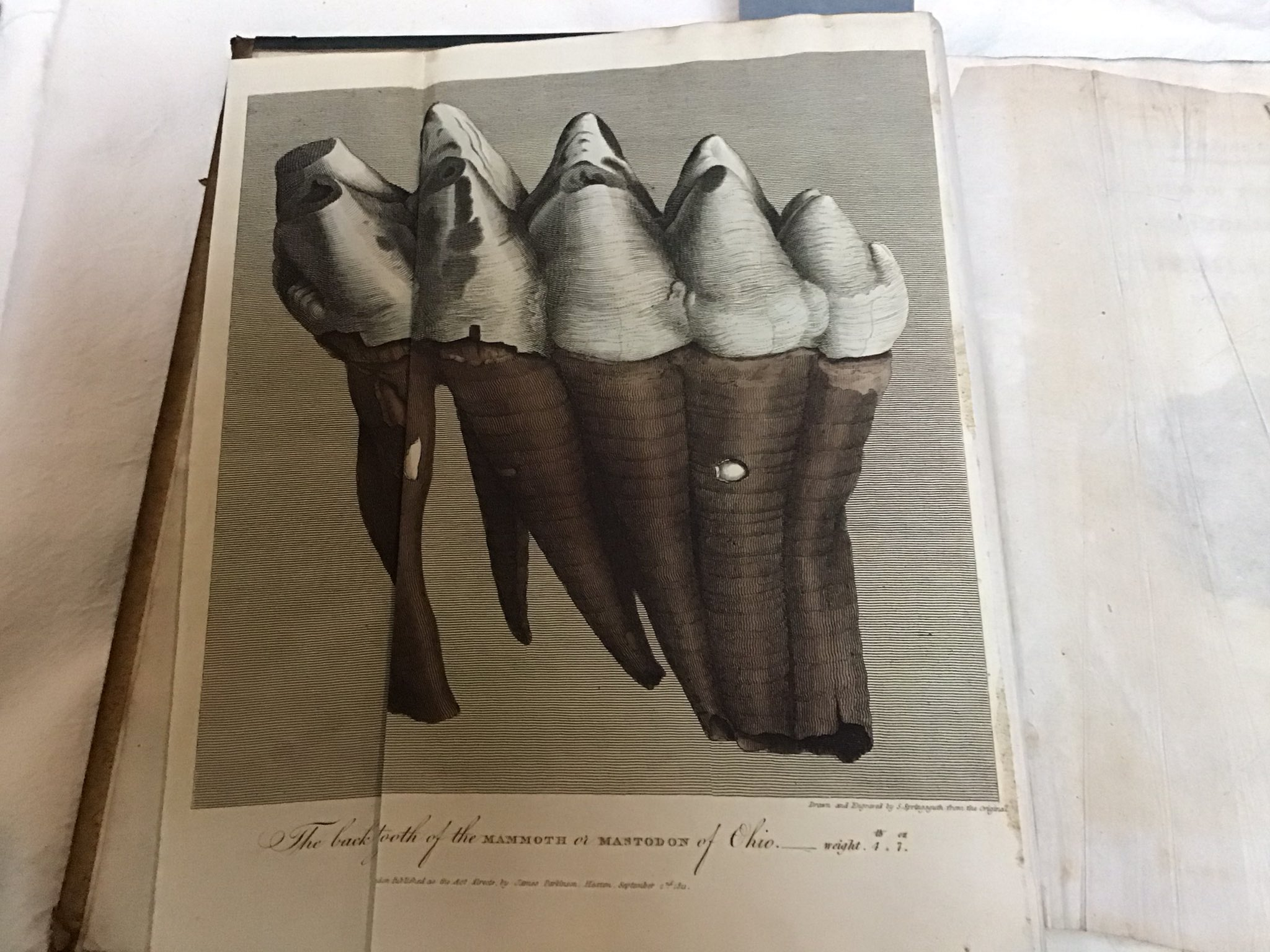“Digging up” James Parkinson’s Organic Remains (1804-1811)

James Parkinson’s lengthily-titled Organic Remains of a former world: an examination of the mineralized remains of the vegetables and animals of the Antediluvian world; generally termed extraneous fossils was published between 1804 and 1811, amongst a background of contemporary speculation about fossils and zoological matter. Parkinson was a surgeon of some repute who found himself drawn to recording and examining these curious remnants of “a former world,” so much so that he published a three-volume work on the subject, complete with illustrations executed by himself and his daughter, Emma.
James Parkinson, (1755-1824), was an interesting and controversial character: in later life, he was said to have been embroiled in an unsuccessful plot to assassinate the “mad” King George III. His work on the “shaking palsy,” (which he was one of the first to identify), led to the condition he observed being named after him: Parkinson’s disease. Over the course of his life Parkinson was a champion for the underprivileged and spoke many times against the Pitt government. He wrote several medical doctrines advocating for the general health and wellbeing of the population, including Medical admonitions addressed to families, respecting the practice of domestic medicine, and the preservation of health (1799), and Hints for the improvement of trusses; intended to render their use less inconvenient, and to prevent the necessity of an understrap. With the description of a truss of easy construction and slight expence [sic], for the use of labouring poor, (1802). He also supported the legal protection of individuals suffering from mental health issues, after serving as a visiting doctor for Holly House, a private insane asylum in Hoxton. His interest in social equality is perhaps reflected in his desire to make his work so accessible, and to write in a manner that appealed to the general reader. Organic Remains is constructed in epistolary form, and includes anecdotes about the beliefs of regional peoples: including the common tendency to call staurolite crystals “fairy stones,” or individual’s accounts of phenomena such as the will of the wisp.
The writer’s own desire to reconcile a divine plan with the evidence in front of him is latent throughout the text. He reflects: “to endeavour to find out the ways of God in forming, destroying, and reforming the earth; do certainly appear to be tasks, to which the limited powers of man are but little adapted.” He was an advocate of Catastrophism, and believed both Creation and Extinction were divinely ordained. In such a vein, his reading of Genesis was that each “day” of Creation actually reflected a much longer period, and that Noah’s flood was one such catastrophe that had shaped the universe. The term he chose for the title of his work “Antediluvian world,” (before the Biblical flood), placed his discussions before one such creation event. Likewise, in his introduction, he promised to attempt “to trace the operations of nature, in periods far behind all human record,” though “the limited powers of man [were] but little adapted” to the task. His work as a whole can therefore be read as an attempt to explain the unexplainable, and to find the godly in the obscure, a controversial justification of a divine being who allowed for “wrecks of former worlds” to appear in the present, amongst a “regular system of dissolution and renovation.”
Parkinson’s fascination with fossils is evident throughout the text. He speaks enviously of the range of specimens held in the museum of an elusive “Dr Strange,” and regularly comments on the “perplexity,” “delicacy” and “extraordinary” nature of the fossils he handles. Each remnant is approached like a mystery to be solved. All, nonetheless, are in his view testament to “the wisdom of the Almighty Creator.” As well as including the advice and information of other learned individuals and enthusiasts who he consults for information, Parkinson also candidly acknowledges the instances in which he is unable to satisfactorily identify the items before him, asserting: “I have placed them here, until more illustrative specimens have pointed out for them a more appropriate situation.” His approach to sharing and disseminating knowledge was a spirit that was both inspired and supported by his involvement with the Geological Society of London, which he founded with twelve other scientists in 1807. Whilst his guide was intended to be accessible and informative, he leaves room for enigmas and puzzles to be solved by feature readers. Indeed, it is perhaps worth noting that at the time Parkinson was writing, paleontology was known by the term orycotology, from Oryktos, meaning “dug up.” It was an idea that he appeared to approach with much interest. In his first volume, he reflected: “the word fossil appears to be the only word our language can supply, which is capable of being employed as the term denoting these substances in general,” due to “their having been dug out of the earth.” This title too came from the Latin, fossilis, to “dig up.” In such terms, Parkinson was a detective of organic remains, which he examined and presented for a public enthusiastic for information.
Several of the specimens Parkinson describes are depicted in carefully-rendered plates, most of which appear as an appendix to the volume. Each book is also decorated with a frontispiece, with the third articulated in colour. 42 copper plate engravings illuminate 1146 pages, most of which were inspired by items in Parkinson’s own substantial collection, kept in his home in Hoxton Square (his museum later caught the attention of the Royal College of Surgeons, but went to other collectors after the price suggested by his wife, Mary, was considered too high). Despite his own drawing talents, it is perhaps notable that Parkinson charged the established engraver Samuel Springsguth, (1769- 1844), with the reproduction of his sketches, though many of Parkinson’s drawings also later reappeared in Gideon Mantell’s, (1790-1852), Pictorial Atlas of Fossil Remains (1850). Overall, Parkinson’s richly-illustrated, ardently researched three-volume examination of Organic Remains was as an important a bestowal to Palaentology as his short monograph on “the shaking palsy” was to medicine. Indeed, he not only gave his name to Parkinson’s disease: an ammonite, nautilus parkinsoni, also attests to his legacy. It is a fitting tribute to a man with such wide and encompassing interests.

“The back tooth of the mammoth or mastodon of Ohio,” engraved by Samuel Springsguth. Frontispiece for Volume III of James Parkinson’s Organic Remains of a former world: an examination of the mineralized remains of the vegetables and animals of the Antediluvian world; generally termed extraneous fossils, 1811.
James Parkinson’s Organic Remains of a former world: an examination of the mineralized remains of the vegetables and animals of the Antediluvian world; generally termed extraneous fossils (1804-1811), Library Collection No. Bay 68 1804 PAR X is currently on display as part of our Myths & Monsters exhibition, which explores the speculations and stories around fossils and zoology in the early to mid 19th century. The display can be viewed in the Outer Library until the end of November 2023.

